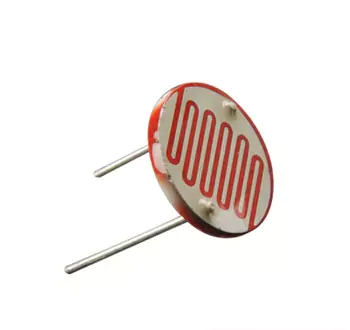What is LDR Sensor?
An LDR sensor (Light Dependent Resistor) is a device that is used to detect light.
It has a (variable) resistance that changes with the light intensity that falls upon it. This allows them to be used in light sensing circuits.
They are used in many consumer products to determine the intensity of light.
An LDR or light dependent resistor is also known as a photoresistor, photocell, photoconductor.
It is one type of resistor whose resistance varies depending on the amount of light falling on its surface. When the light falls on the resistor, the resistance changes. To sense the presence of light these resistors are often used.
These resistors have many functions and resistances.
For instance, when the LDR is in darkness, then it can be used to turn ON the light or to turn OFF the light when it is in the light.
Related Article: How to interface LDR Sensor with Arduino

How Does an LDR Sensor Work?
The working principle of an LDR sensor is fascinating. Also known as a Light Dependent Resistor, it operates based on the variation in light intensity that falls on its surface. When exposed to light, the resistance of the LDR decreases, allowing current to flow through it.
This change in resistance is utilized by electronic circuits to determine the light levels in a given environment. The sensor’s sensitivity can be adjusted by varying factors such as material composition and size.
LDR sensors are commonly used in various applications including street lights, camera exposure control, and automatic night lights. By detecting changes in ambient light conditions, they help automate processes that rely on light detection.
LDR Pinout
The pinout typically consists of two pins: one for power (Vcc) and another for ground (GND). These pins provide the necessary voltage for the sensor to function effectively.
The bigger one wire is +ve of LDR and the other is -ve.
Specifications of LDR
When it comes to the specifications of an LDR sensor, there are key factors to consider. The resistance range is crucial, typically ranging from a few hundred ohms in bright light to several megaohms in darkness.
The spectral response indicates the sensitivity of the sensor to different wavelengths of light, with variations depending on the materials used in its construction.
Moreover, the rise and fall time of an LDR sensor determines how quickly it can adjust to changes in light intensity. This parameter is significant for applications requiring fast response times.
Additionally, the power consumption of an LDR sensor should be taken into account, especially for battery-operated devices where energy efficiency is vital.
| Max power dissipation | 200mW |
| Max voltage @ 0 lux | 200V |
| Peak wavelength | 600nm |
| Min. resistance @ 10lux | 1.8kΩ |
| Max. resistance @ 10lux | 4.5kΩ |
| Typ. resistance @ 100lux | 0.7kΩ |
| Dark resistance after 1 sec | 0.03MΩ |
| Dark resistance after 5 sec | 0.25MΩ |
Common Applications of LDR Sensors
LDR sensors, also known as Light Dependent Resistors or photocells, find a wide range of applications across various industries. One common use is in streetlights and outdoor lighting systems. By detecting changes in ambient light levels, LDR sensors can automatically turn on lights at dusk and off at dawn.
Another prevalent application is in security systems. LDR sensors are often integrated into alarm systems to detect unauthorized entry by monitoring changes in light intensity within a premises. This enables prompt notification of any suspicious activity.
Moreover, LDR sensors play a crucial role in camera technology. They help cameras adjust exposure settings based on available light to capture high-quality images under different lighting conditions.
In addition, LDR sensors are utilized in agricultural automation for greenhouse climate control. By measuring sunlight levels, these sensors assist in regulating temperature and humidity to optimize plant growth.